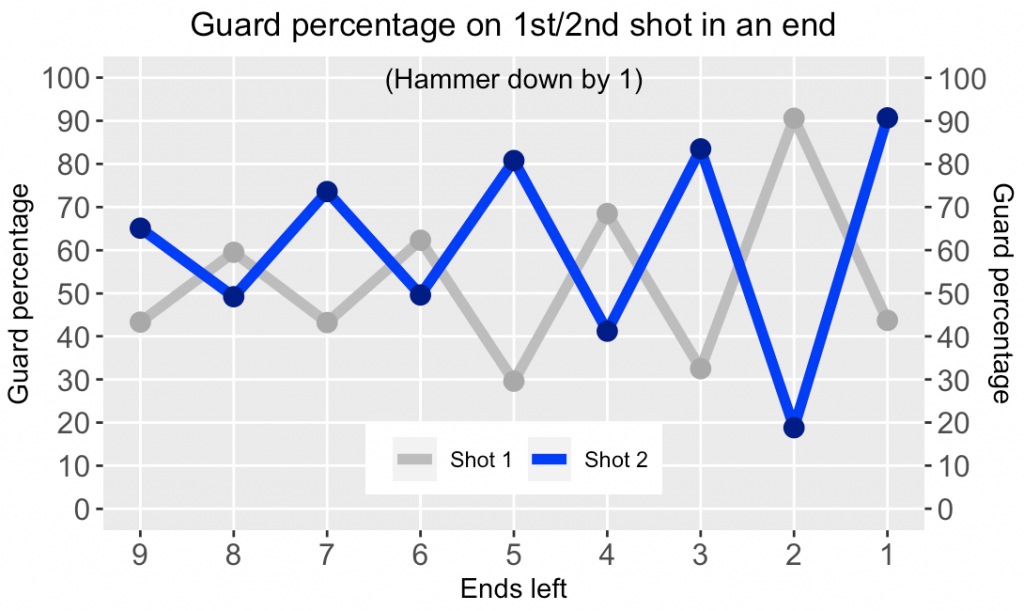Last week we looked at the tendency of the team throwing the first stone to guard and how that is strongly related to whether an end is even or odd. In this post, we’ll look at the tendency of the hammer team in these circumstances.
Let’s get right to the graph. (This blog is going to become my own personal playground for improving my ggplot skills.)

The blue line is the first-shot guard percentage of the team with hammer and the grey line is the guard percentage of the team without hammer (as featured in last week’s post). They are practically mirror images. The hammer team is more likely to throw early guards in even ends (odd ends remaining), under the belief that scoring in these ends is more important to winning the game.
But being the second shot of the end, there’s some context to consider. If the first shot by non-hammer is a guard, hammer is much less likely to throw a guard themselves.

You can also see how those lines converge indicating that hammer’s choice is less influenced by non-hammer’s choice as we get closer to the end of the game. Not surprising, but neat to see in graphical form nonetheless.
Last week we saw that the strategy of teams Bottcher, Gushue, and Epping were affected the most by even-end theory when they didn’t have hammer. And among the 37 teams with at least 15 shots in both even and odd ends with hammer and down 1, Gushue ranks fourth in even-end splits, guarding 95% of the time in even ends but just 45% of the time in odd ends.
However, Bottcher and Epping are both middle-of-the-pack in their splits. One thing that doesn’t change is Bottcher’s reluctance to guard. He has the 5th-lowest guard rate in even ends and the 3rd-lowest in odd ends. When hammer trails by one, Bottcher avoids early guards more than almost any other team out there, whether he has hammer or not.
Not everyone is so consistent. Jason Gunnlaugson is very aggressive without hammer but very defensive with hammer, guarding only 32% of the time in even ends (the lowest rate in the group) and 25% of the time in odd ends.
Finally, the award for the team that cares least about even ends with hammer and down one is Rachel Homan. She has guarded 83% of the time in even ends and 90% of the time in odd ends. She is going to get aggressive with hammer and down one regardless of the end.
Last week in curling: With the bonanza of events over the upcoming Canadian Thanksgiving weekend, the past week was quiet on this side of the ocean. The US held its final qualifying events for the Olympic trials but the biggest news regarding the chase for a trip to Beijing was that Jamie Sinclair won the Atkins Curling Supplies Classic in Winnipeg. It wasn’t a strong field, but if Sinclair is going to challenge Peterson at the trials, she should be winning events like this. There is now a pretty clear separation between Team Sinclair, who moved up to #17, and Cory Christensen (#30) for the second-best team in the US.
Elsewhere, there’s a good rule of the thumb that the biggest event on any given weekend is where Wayne Middaugh is, and he was in Switzerland last weekend to coach Team Hasselborg at the Women’s Masters Basel. Hasselborg played well, but fell to Denmark’s Team Dupont in the final. Both teams were content to play a defensive style most of the game. (Indeed, shot data confirms that Team Dupont is one of the most defensive teams you’ll ever see at this level.)
Dupont went a combined 4-17 in the 2018 Olympics and 2019 Worlds but turned that around in last year’s worlds. With Mathilde Halse playing third, the Danish team went 8-5 and finished fourth in round-robin play. Team Dupont moves from #20 to #14 in the world with the win last week but we could use more data on them. Their only other action between the worlds and last weekend was at Curling Night in America, the results of which are under government seal until the event is aired. Still, it seems Denmark will be at least an outside medal threat at Beijing.
And I’m really hoping the wacky-pose edition of the trophy photograph catches on.